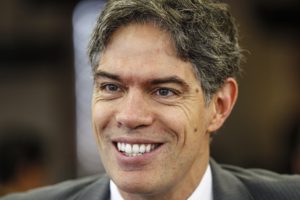Diamonds by Rapaport
Nov/2011
Por Camila Fontana
Brazil Rising
With strong fundamentals, the Brazilian economy is weathering the global crisis and attracting a wealth of foreign capital.
While developed nations continue to grapple with financial crisis and economic slowdown, Brazil is wooing the world with vibrant growth, a new middle class of enthusiastic consumers, fiscal and political stability, heightened international visibility and a positive forecast for solid economic expansion in the years to come.
This was not always the case. Brazil suffered through decades marred by economic stagnation, excessive foreign debt, hyperinflation and unstable currencies. But today the country is dealing with problems that most developed nations would love to have. Credit has been tightened to curb consumer spending, which was being fueled by a record low unemployment rate and greater availability of bank loans. The government has imposed tax and trading restrictions to moderate gains in the exchange rate, which were being caused by a colossal inflow of foreign investment. Companies have been forced to lift wages amid a shortage of workers.
Brazil’s newfound prosperity has its roots in a government plan designed in the early 1990s to combat hyperinflation, which peaked at an annual rate of 6,821 percent in April 1990. Since then, with democracy stabilized after a two-decade-long military dictatorship, the country is now ruled by Dilma Rousseff, its first female president and its first economist as president. After nearly collapsing in 1995, the financial system was put under strict control of the country’s central bank, which undoubtedly helped it emerge virtually unscathed from the 2008 global crisis. Sound fiscal and monetary policies have turned the South American giant into a net foreign creditor, reversing a history of bailouts by the International Monetary Fund (IMF).
With its political and economic house in order, Brazil received its first investment-grade rating in 2008, which unleashed a torrential flow of foreign capital to its financial markets. Notwithstanding a recent slide, the country’s benchmark Bovespa stock index has risen six-fold since 2003. Foreign direct investment also climbed nearly five-fold in the same period to $48.5 billion in 2010, and the central bank expects it to hit a record $70 billion in 2011.
A Bit of Luck
External factors and a dose of luck also have helped. A rally in global commodity prices increased foreign trading profits for Brazil, the world’s largest exporter of poultry, coffee, sugar and iron ore. In 2009, China became Brazil’s largest trading partner, and the South American nation became less reliant on the U.S. economy, its most important partner until then. And it hasn’t hurt that state-owned oil company Petrobras made the largest oil discovery in the Americas since 1976, and plans to invest $225 billion over five years to develop those offshore fields.
Exploding Middle Class
Gross domestic product (GDP) grew 7.5 percent in 2010, the fastest growth in a quarter of a century. Brazil’s so-called “virtuous” economic cycle — in which strong growth boosted job creation — led to the current 6 percent unemployment rate, the lowest on record. More jobs, higher wages, government subsidies to eradicate extreme poverty, declining interest rates and greater credit availability also support consumer spending. As a result, nearly 40 million people have joined the middle class in the past eight years.
Today, 50.5 percent of Brazilians are part of the middle class, a total of 95 million people, according to the Center for Social Policies at Getulio Vargas Foundation in São Paulo. That share will widen to 60.2 percent by 2014, says Marcelo Neri, the chief economist at the center, who was also a board member in the Council for Economic and Social Development under former Brazilian President Lula da Silva.
“Growth in Brazil has been highly inclusive. This is the main driver for the birth of a new middle class,” says Neri. “The new middle class is here to stay.”
With their newfound wealth, Brazilians have been snapping up everything from cars and household appliances to clothing and real estate. Retail sales grew more than 10 percent in the 12 months through July 2011 and contributed to push annual inflation to more than 7 percent — its highest level in six years and above the government’s target range. Authorities reacted to the pickup in inflation by initiating a round of interest rate hikes in late 2010, but they changed course in August in response to the deterioration in the global growth outlook caused by the European debt crisis. The benchmark interest rate in the country now stands at 12 percent, the highest among major economies.
Recent Slowdown
Turbulence in financial markets and fears caused by debt problems in the U.S. and Europe hit Brazil right at the time when restraining measures imposed by the government were starting to have an effect. As a result, in late September 2011, the Brazilian central bank slashed its forecast for GDP growth in 2011 to 3.5 percent from 4 percent.
The cut was driven “mainly by the deterioration in the international scenario, which has led to overall reductions of large magnitude in growth forecasts for the main economic blocks,” according to the central bank’s report.
Likewise, consumer spending and job creation are expected to lose steam. The IMF estimates the unemployment rate in Brazil will rise to 7.5 percent in 2012. There also are setbacks on the political scene, with no fewer than five cabinet ministers of President Rousseff ousted between June and September of 2011— four of them under corruption accusations. Government programs to reduce poverty and support the economy are expected to shrink, after the Rousseff administration pledged to cut approximately $28 billion from the 2011 budget to help control inflation and shore up government accounts.
Look Ahead
Though near-term economic prospects have worsened for virtually all countries amid the global turmoil, Brazil is expected to suffer less than most, as was the case in 2008. Unlike other large developed nations whose governments have already slashed interest rates to near zero and can hardly afford to stretch public debt further, the Brazilian government still has plenty of room to cut interest rates and hike spending to boost the domestic economy if needed.
The fact that Brazil will play host to both the Soccer World Cup in 2014 and the Summer Olympic Games in 2016 will ensure that economic activity will remain heated in upcoming years, even if there are bumps on the road, according to Ricardo Amorim, chief executive officer (CEO) of Ricam Consultoria, a São Paulo–based economic and financial consulting firm.
“It is almost inevitable that things will work out in Brazil” in the next five years, says Amorim. “Brazil is probably one of the best places in the world right now for productive investment.”
To be sure, structural problems in the country aren’t going away any time soon. Among the most prevailing issues are the overstretched transportation infrastructure, a blackout-prone electricity grid, cumbersome tax legislation, a slow and unreliable justice system, a high crime rate and poor public education. Improvement in these areas — along with continued economic prosperity and consumer confidence among the middle class — will determine if Brazil will have more than its 15 minutes of fame on the global stage.
Editor’s Note: Camila Fontana worked as a business reporter for 11 years in New York City before moving to São Paulo, where she is a freelance video reporter, translator and writer for business and consumer magazines.




